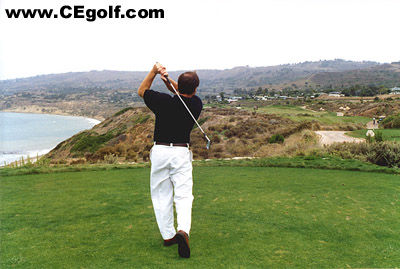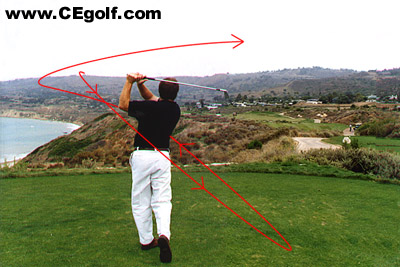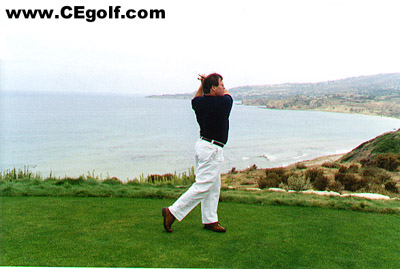
The Follow Through
All pictures were taken at Ocean Trails Golf Club, which is now Trump National Golf Club Los Angeles, in Rancho Palos Verdes, California.

The first picture shows a considerable amount of wrist cock early into the follow through. This is a classic sign of a golf swing in which the arms and body are at odds with one another. More specifically, it means that the golfer has blocked the release and had to roll the arms over and flip the club in an effort to find a way to get the club square at impact. Any type of late manipulation such as this will affect one's overall consistency and their ability to hold up under pressure.

The second picture is the typical follow through position of someone who manipulates this way. The swing was blocked because the arms didn't swing around the body enough so the only place the club can go is up and then back down over the shoulder (down the back). There was a time when this used to be considered a correct follow through position, but it is now uncommon among good players.

In picture three, I am showing what it would look like if my body and arms worked together reasonably well. Notice the extension (wrists still fully uncocked), which is due to the absence of wrist flipping and little or no arm rotation (roll). If the body and arms work correctly, there is no need for the arms to roll over as in the first picture above (there is a little roll around shoulder high, long after impact, due to momentum).
When the swing isn't manipulated, the wrists only begin to cock at the very end of the follow though due to momentum as the arms finally begin to slow. Ben Hogan was the best at this, but Jack Nicklaus and Moe Norman were also exceptional at not rolling the arms and maintaining extension into the follow through!

The fourth picture shows a follow through position in which the body obviously worked around, rather than sideways as it would in an overly upright swing. The red line shows the general nature of the swing plane and path of the clubhead (I've exaggerated the flatness of the line for illustrative purposes) for a swing in which the body works correctly.

The fifth picture shows this same follow through from a different angle. Note the club is almost horizontal rather than down the back. With harder swings there will be more downward momentum at the end of the swing, but it is a wrapping around the body motion rather than the down the back position shown in the second picture.
If you're having trouble with the navigaton bar (left), try the CEGolf.com Contents page.
Casey Eberting Golf Instruction
©Copyright 1997-2024, All Rights Reserved